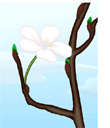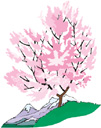
Cherries are a fruit that comes from the cherry tree.
- botanical information
- origin
- history
- nutritional information
- selection
- storage
- magick correspondences and uses
- ritual uses
- Goddesses and deities
- health care
- Chinese herbology
- external skin care
botanical information:
Botanical name: Prunus avium or Prunus serotina
Common name: cherry
Use the botanical name when ordering seeds (bulbs, etc.) or when looking up information in the library. Common names vary by nation, culture, and region, and sometimes the same common name is applied to different plants.
Cherry belongs to the rose family. Cherry trees average 60 to 80 feet and live until 150 to 200 years.
Cherry wood is used for making fine furniture, cabinets, musical instruments, and carvings. The heartwood of cherry ranges from rich red to reddish brown and darkens with age and exposure to light. The sapwood of cherry is creamy white.
origin:
Origin: Japan.
The cherry blossom was considered sacred to the Japanese emperor.
history:
History: In 1885 travel writer and photographer Eliza Ruhamah Scidmore of the U.S. started working with the Japanese government to arrange for chery trees to be planted along the Potomac River in Washington, D.C. After years of negotiations the people of Tokyo donated 3,000 cherry trees to the people of Washington. On March 27, 1912, Helen Taft (wfie of the U.S. president) and Viscountess Chinda (wife of the Japanese Ambassador) planted the first two cherry trees. Approximately 150 of the original 1912 trees, including the first two planted, are still alive.
nutritional information:

Cherries are a food that increases sexual energy and enhances fertility.
American colonists mixed cherry juice with rum to make a bitter cordial called Cherry Bounce.
See also Chinese herbalism below for Chinese gender and Chinese flavor.
selection:
Reason to choose organic:
Cherries have the number seven (7) highest pesticide load of 45 common fruits and vegetables studied in 2006 by the Environmental Working Group and is therefore a prime candidate for switching to organic. The EWA explains, “While washing and rinsing fresh produce may reduce levels of some pesticides, it does not eliminate them. Peeling also reduces exposures, but valuable nutrients often go down the drain with the peel. The best option is to eat a varied diet, wash all produce, and choose organic when possible to reduce exposure to potentially harmful chemicals.”
According to USDA and FDA tests on commercially grown foods collected between 2000 and 2005, cherry has a 91.4% (percentage) of samples tested with detectable pesticides, a 75.8% (percentage) of samples with two or more pesticides, a 2.8 average number of pesticides found in a sample, an average of 0.290 parts per million of all pesticides found, and 25 different pesticides found in use growing cherries. These toxic pesticides don’t apply to organic foods.
storage:
Storage: Eat cherries within two days of purchase.
Cherries last longer with the green stems attached.


magickal correspondences and uses:
Incense: Cherry (wood or blossom) incense or wood or blossom or oil is appropriate for burning in love spells, such as the Aphrodite New Moon love spell, Hecate black candle love spell, or Isis Full Moon love spell.
Gender: feminine (traditional western European magickal gender)
Western element: water
Magickal uses of cherry juice: love, platfulness, and psychic energy
Love spells: Cherry blossoms are appropriate for use in love spells, such as the Aphrodite New Moon love spell.
Magick food for love spells: Cherry (both fruit and juice) is an appropriate food for love spells, such as the Aphrodite New Moon love spell, Hecate black candle love spell, or Isis Full Moon love spell. See the article on foods for more information on using food magick in spells.
Magickal substitutions: Rosemary usually may be safely substituted for any herb in magick spells and rituals. Roses may safely be substituted for any flower.

Magical Uses information courtesy of 
|
ritual uses:
Ritual uses of cherry: Use in rituals where creativity or sensitivity is needed.
Ritual uses of cherry beverages: Use cherry flavored beverages in rituals honoring youthful Goddesses.
deities associated with cherry:
- any youthful Goddess
Early American colonists used cherry bark to make a drug to treat bronchitis. They used cherry stalks to make various medicinal tonics.
health care uses:
Health Notice: Attempting to be an amateur doctor is potentially dangerous to your health. This web page is not professional medical advice. Nothing on this website should be considered as a substitute or replacement for professional medical advice. Persons should seek the advice of qualified health providers. Self-medication should not be used as a substitute for professional medical care. Please confirm all self-medication with your doctor or health care professional. See the article on healing for recommended healers.
Chinese herbalism:
Chinese gender: yang (warm)
Chinese flavor: sweet
external care:
 External skin care: Wild cherry bark extract in Rhonda Allison Cherry Jubilee Enzyme: “Filled with enzymes rich in antioxidants. Mask includes cherry puree, pomegranate, lycopene from tomatoes, and red berries. The primary benefit of this enzyme is the natural polyphenols (flavanoids) that are incredibly rich in antioxidants. This formula contains potent anti-aging value that fights against free radical damage and aids in building healthy skin tissue. It is the deterioration by free radicals that causes the internal aging of the skin.” Rhonda Allison Cherry Jubilee Enzyme
External skin care: Wild cherry bark extract in Rhonda Allison Cherry Jubilee Enzyme: “Filled with enzymes rich in antioxidants. Mask includes cherry puree, pomegranate, lycopene from tomatoes, and red berries. The primary benefit of this enzyme is the natural polyphenols (flavanoids) that are incredibly rich in antioxidants. This formula contains potent anti-aging value that fights against free radical damage and aids in building healthy skin tissue. It is the deterioration by free radicals that causes the internal aging of the skin.” Rhonda Allison Cherry Jubilee Enzyme
Some herbs may be poisonious under some conditions. Exercise appropriate care.
Wild gathering: Avoid wild gathering. Some plants are endangered species. Some plants can be toxic just by touch. Even experts can make deadly misidentifications of wild plants. Please grow your own herbs in your own goddess garden.













